Learn how to keep your natural stone bathtub looking its best for years to come. This article covers everything from choosing the right type of stone to sealing and cleaning your rectangular bathtub
There's nothing quite like the feeling of sinking into a warm, luxurious bath in a natural stone rectangular bathtub. The cool, smooth surface of the stone feels amazing against your skin, and the natural beauty of the stone adds a touch of elegance to your bathroom.

But while natural stone bathtubs are beautiful, they also require a bit of special care to keep them looking their best. That's where this blog post comes in! In this article, we'll share some essential tips for maintaining your natural stone rectangular bathtub, so you can enjoy it for years to come
We'll start by talking about the different types of natural stone that are used in bathtubs, and how the type of stone can affect the maintenance routine. Then, we'll provide step-by-step instructions for regular cleaning, sealing, and stain removal. We'll also offer some tips for preventing scratches and damage, and for maintaining the surrounding area.
So whether you're a proud new owner of a natural stone rectangular bathtub, or you're just thinking about getting one, this blog post is for you! Read on to learn how to keep your bathtub looking its best for years to come
The type of natural stone used in your bathtub will affect the maintenance routine. Here are some of the most common types of natural stone used in bathtubs, along with their unique characteristics:
Marble is a soft stone that is susceptible to scratching and staining. It is also a porous stone, which means that it can absorb moisture. Marble bathtubs should be sealed regularly to protect them from stains and moisture damage
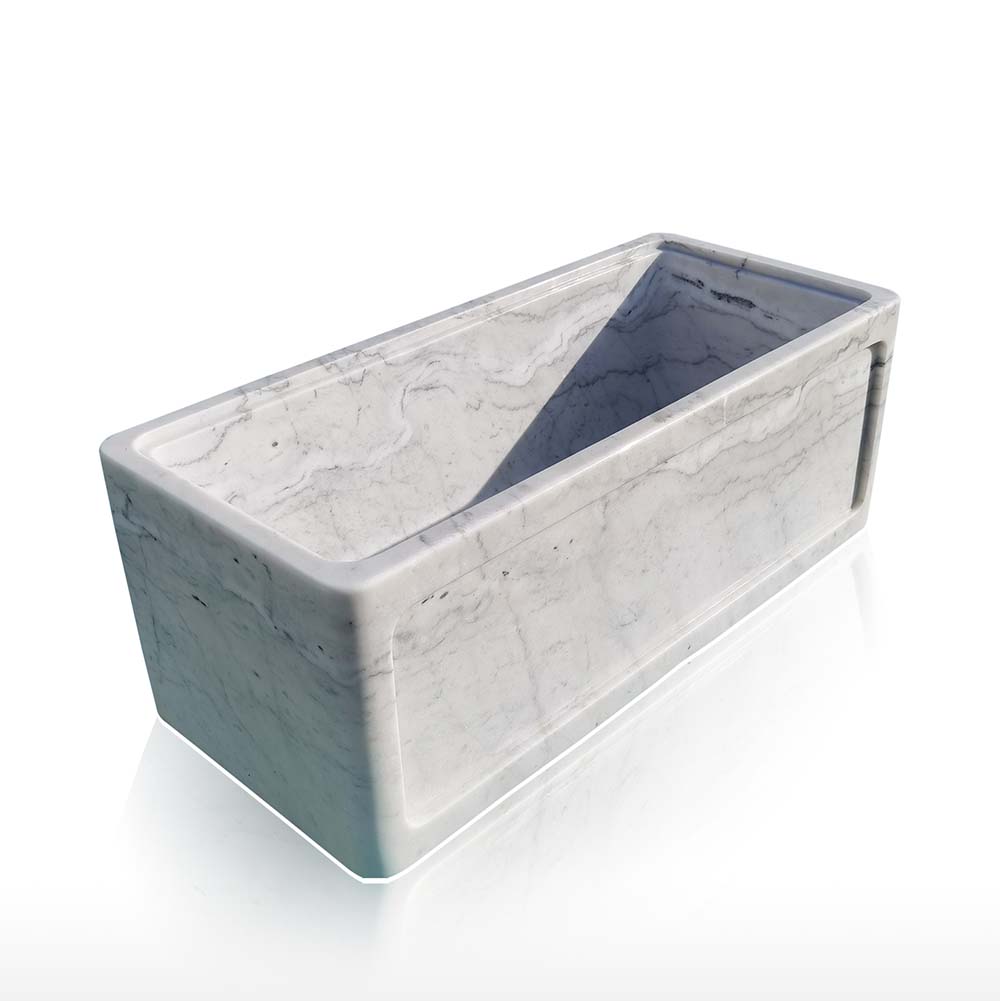
(Sleekly Modern Natural Marble Stone Bathtub)
Granite is a hard stone that is resistant to scratching and staining. It is also a non-porous stone, which means that it does not absorb moisture. Granite bathtubs do not need to be sealed as often as marble bathtubs
Travertine is a type of limestone that is characterized by its natural pits and pockmarks. It is a relatively soft stone that can be scratched, but it is also a non-porous stone that does not absorb moisture. Travertine bathtubs should be sealed regularly to protect them from staining
Onyx is a type of chalcedony that is characterized by its translucent or semi-translucent properties. It is a relatively soft stone that can be scratched, and it is also a porous stone that can absorb moisture. Onyx bathtubs should be sealed regularly to protect them from staining and moisture damage
Keeping your natural stone bathtub clean is important for maintaining its appearance and preventing stains. Here are some regular cleaning tips:

(Contemporary Black Marble Bath)
Sealing your natural stone bathtub will help to protect it from stains and moisture absorption. Here are some tips for proper sealing
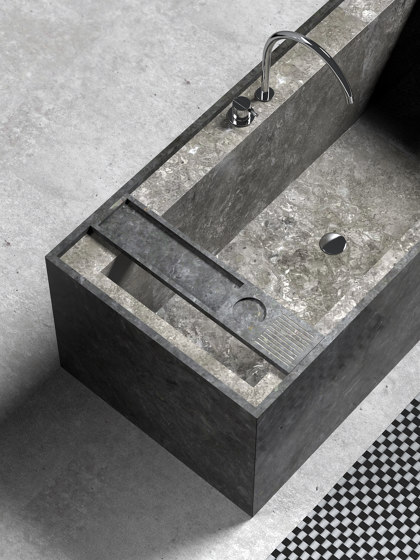
By following these tips, you can help to keep your natural stone rectangular bathtub looking its best for years to come
Here are some fun tips to keep in mind:
By following these tips, you can make cleaning your natural stone bathtub a fun and enjoyable experience
Stains and spills can happen to the best of us. But don't worry, there are ways to deal with them without damaging your natural stone bathtub. Here are some tips:
The sooner you clean a stain, the easier it will be to remove.
Different stains require different cleaning methods. For example, soap scum can be removed with a mild soap and water solution, while rust stains can be removed with a vinegar solution.
Harsh chemicals can damage the surface of your bathtub.
Don't scrub too hard, as this can scratch the surface of the stone
Be sure to rinse away all of the cleaning solutions to prevent it from drying and leaving a residue
Here are some tips to help you prevent scratches and damage to your natural stone bathtub:
Use a soft brush or cloth when cleaning. Abrasive materials can scratch the surface of the stone.
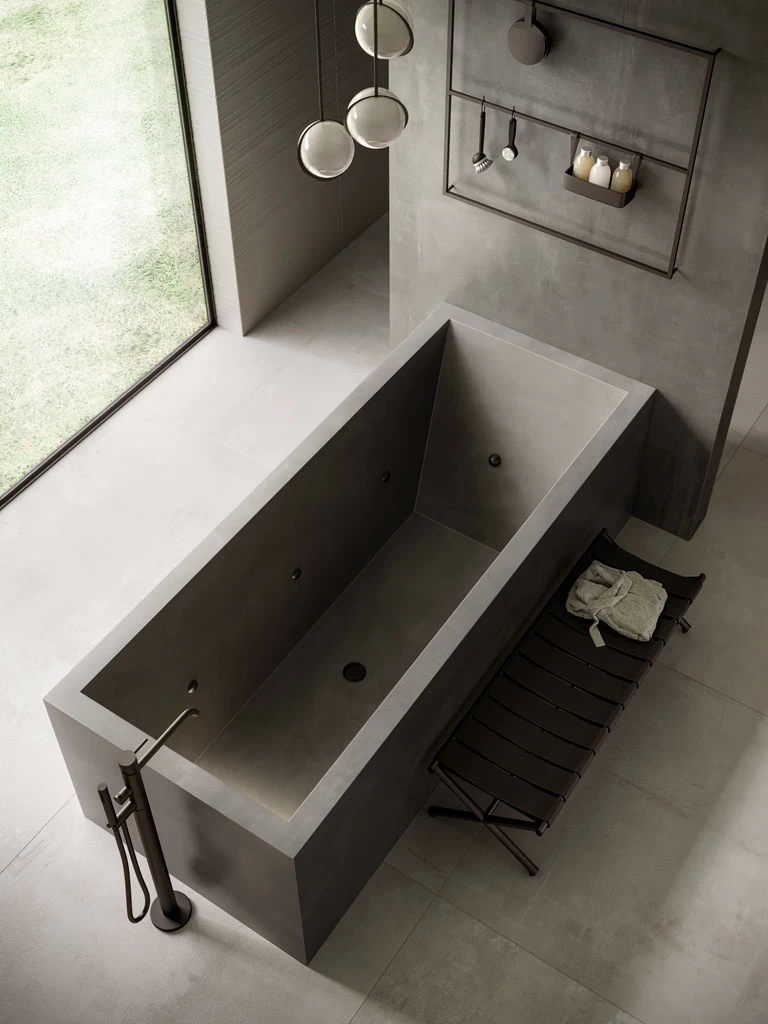
Avoid using sharp objects or tools in the stone bathtub. Even a small scratch can damage the surface of the stone.
Be careful when getting in and out of the bathtub. Don't drag your feet or bang your body against the sides of the bathtub.
Place a bathtub mat or towel in the bottom of the bathtub to prevent slipping.
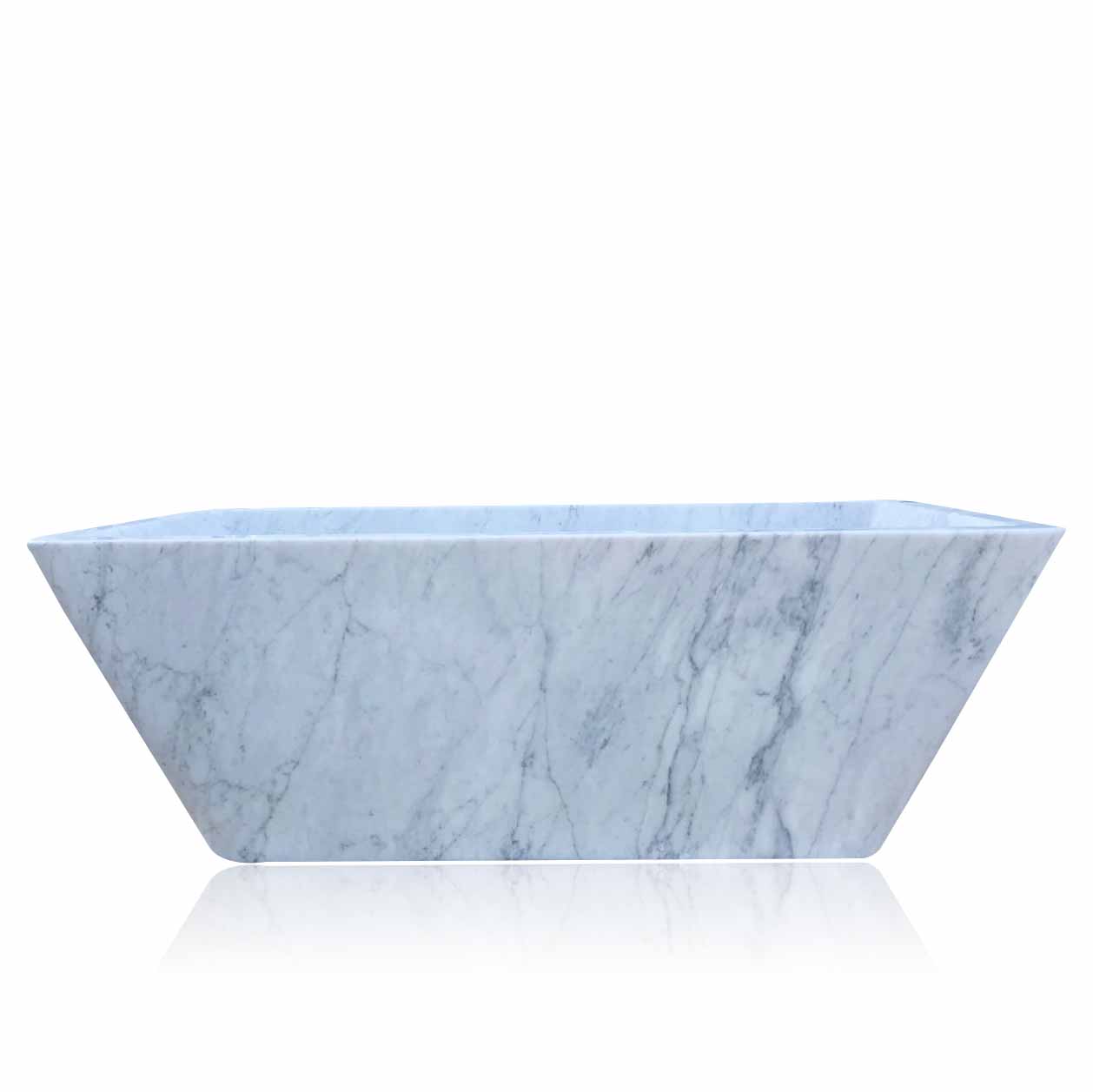
(Slant Edge Marble Stone Bathtub)
If you have a heavy buildup of dirt, soap scum, or other debris, or if you have a stubborn stain that won't come out with regular cleaning, you may need to use a more aggressive cleaning method. Here are some tips:
Don't panic if you see a stain. Most stains can be removed with a little bit of effort.
Try a commercial cleaner that is specifically designed for natural stone.
Mix a paste of baking soda and water and apply it to the stain. Let the paste sit for a few hours before scrubbing it away.
Use a poultice of baking soda and water. Apply the poultice to the stain and cover it with plastic wrap. Let the poultice sit for a few days before removing it.
Don't be afraid to ask for help. If you're not sure how to remove a stain, you can always consult with a professional stone cleaner.
The surrounding area of your natural stone bathtub should also be kept clean and maintained. This will help to create a cohesive look in your bathroom and prevent the spread of dirt and debris.
Here are some tips for maintaining the surrounding area of your natural stone bathtub:
Clean the surrounding tiles or flooring after each use. This will help to remove any dirt, soap scum, or other debris that may have accumulated.
Use mild soap and water or a commercial cleaner that is specifically designed for natural stone. Avoid using harsh chemicals, as these can damage the surface of the stone.
Be gentle when cleaning. Use a soft brush or cloth to clean the surrounding area. Avoid using abrasive cleaners or scrubbers, as these can scratch the surface of the stone.
Water spillage can cause damage to your natural stone bathtub and the surrounding area. Here are some tips for avoiding water spillage and damage:
Place an oval bathtub mat or towel in the bottom of the bathtub to catch any excess water
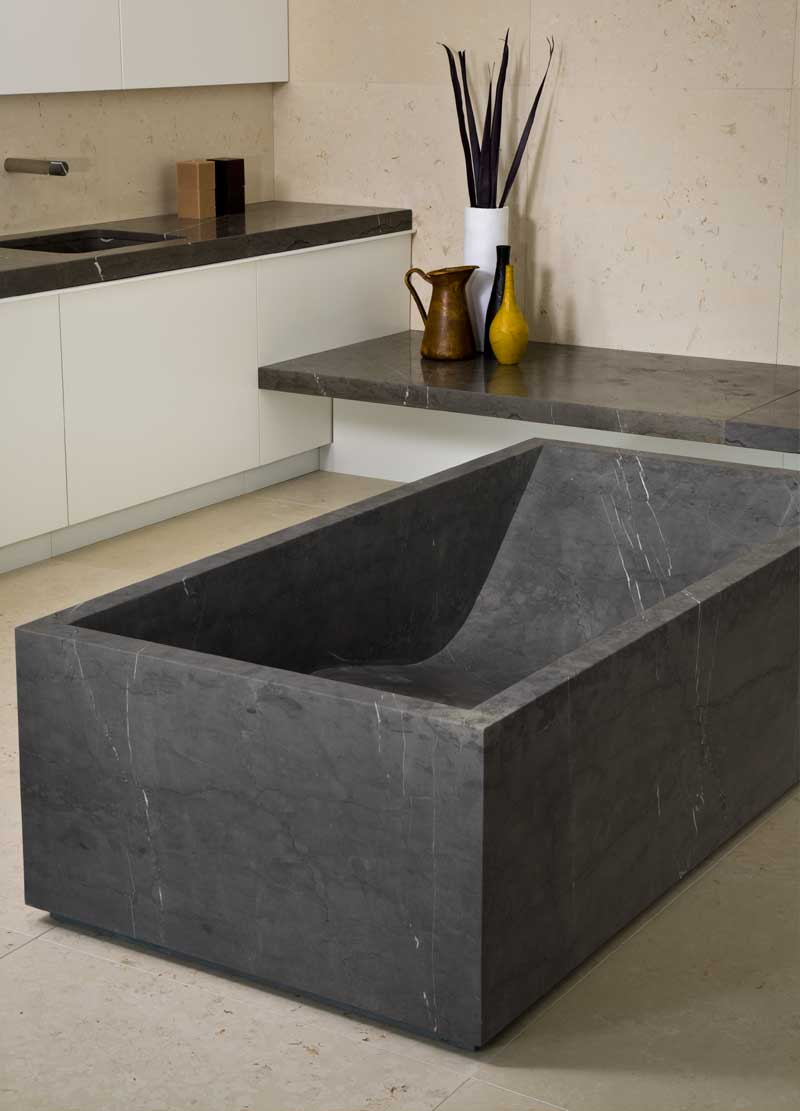
Wipe down the surrounding area after each use. This will help to remove any excess water that may have spilled over.
Be careful not to drop anything heavy in the deep rectangular bathtub. This could cause the bathtub to crack or chip.
The climate in your area can also affect the maintenance of your natural stone bathtub. Here are some tips for seasonal maintenance:
In the winter, seal your bathtub more often to prevent moisture absorption.
In the summer, use a dehumidifier in the bathroom to reduce humidity
Be aware of any changes in the weather that could affect your bathtub. For example, if there is a sudden change in temperature, you may need to seal your bathtub more often.

Following the tips in this article, you can help to keep your natural stone bathtub looking its best for years to come. But if you're looking for a new rectangular freestanding bathtub, you should definitely check out Classybaths. We are experts in creating quality natural stone bathtubs.
Classybaths uses only the finest natural stones, such as marble, granite, and travertine. We also offer a wide variety of styles and designs to choose from. So whether you're looking for a traditional or modern bathtub, Classybaths has something for you.
If you're interested in purchasing a natural stone bathtub from Classybaths, you can visit our website or contact us for more information. we would be happy to answer any questions you have and help you find the perfect bathtub for your needs.
The best type of natural stone for a bathtub depends on your personal preferences and needs. Some popular options include marble, granite, and travertine. Marble is a soft stone that is susceptible to scratching and staining, but it is also very beautiful. Granite is a harder stone that is more resistant to scratching and staining, but it is also more expensive. Travertine is a type of limestone that is characterized by its natural pits and pockmarks. It is a relatively soft stone that can be scratched, but it is also a non-porous stone that does not absorb moisture.
The frequency with which you need to seal your natural stone rectangular bathtub will depend on how often it is used and how exposed it is to moisture. However, most experts recommend sealing your bathtub every one to two years.
You should use a mild soap and water solution to clean your natural stone bathtub. Avoid using harsh chemicals or abrasive cleaners, as these can damage the surface of the stone.
The type of stain will determine the best way to remove it. For example, soap scum can be removed with a mild soap and water solution, while rust stains may require more aggressive treatment.
Avoid using sharp objects or abrasive materials in the rectangular freestanding bathtub. Be careful not to drop anything heavy in the bathtub. Use a soft brush or cloth to clean the bathtub. Seal your bathtub regularly.